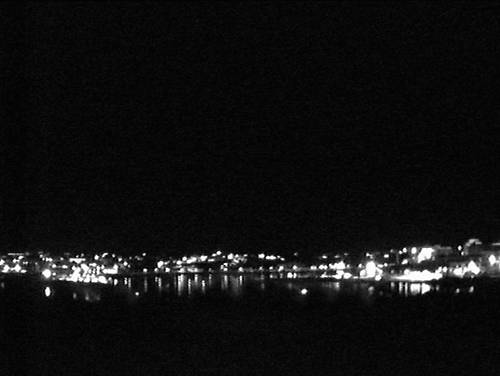
Another artist/filmmaker I’m interested in for the ‘Night Vison‘ program is Pieter Geenen, who has been working on a series of impressive audio and video works in which he examines the perception of landscapes, especially nocturnal ones. In his video installation ‘nocturne (lampedusa – fort europa)’ (2006), possibly the centre piece of this series, he explores the nighttime atmosphere of the island of Lampedusa – the closest European point to the north of the African continent, which has in recent years become a haven for asylum seekers from Africa, Asia and the Middle East. In the video “an infrared camera registers several spots on and around the island, in search for traces of this striking story. The dark, abstract and suggestive landscapes give a nocturnal impression of the island by showing places and areas like the island’s small airport, its town and harbor, the refugee centre, military zones and other well guarded areas, the coastal area,… Human presence has been reduced to some anonymous, unidentifiable luminous dots, or to the suggestive black space between them. That’s how this essay on Fort Europe and the nocturnal phenomenon would like to offer an alternative for the images and information given by traditional media”.
‘nocturne (lampedusa – fort europa)’, 2006, 28′, video 4:3, black & white, silent, infrared camera, mini DV (5′ trailer)
He has also made a series of nocturnal sonic landscapes, titled ‘Nightscapes’.
“In general contrast to the visual, the auditory field is rather mental then physical, less restrained, and its contours are variable and uncertain. At night this contrast becomes even stronger. Within human perception, the night as a phenomenon seems to go with a different sort of time awareness. The night is more undefined, further away and more unlimited than the day. The night is a state of mind, its beginning and ending unclear.
nightscape is a series of nocturnal sonic landscapes. Each piece presents the aural experience of a landscape at night, consisting only of the specific, natural and genuine sound of that landscape. They are always presented in the context of a dark space: as a continuous installation one can walk freely in and out, in a ‘screening’ situation with a seated audience or with headphones for a personal listening session. One hears the monotonous, muted and repetitive sounds of night, as if being in front of a broad landscape. Nothing’s visible.
In contrast to our strongly visual orientated society, the listener is depended on his hearing only in this artificial nocturnal situation. Although every visual element is eliminated, nothingness cannot exist for there is always imagination.
The listener’s auditive focus increases, as that is also the effect of a real nocturnal environment on one’s hearing. Through causal listening (identifying an invisible sound source by making logical connections or possessing any foreknowledge) he can gain a certain level of understanding and connote the sounds to images and meanings which can be mentally merged into a logical whole. Sound is absorbed trough the ears but perceived mainly through mental processing. Apart from their suggestive qualities, these sounds exist on itself as well, as abstractions of their source and its initial sound, detached from any connotation.
In a subtle way, through minimal and ‘monochrome’ nocturnal sound, every nightscape sketches and bears a different nocturnal space, a sonic landscape. nightscape is a formal abstraction of the night, embedding a latent narrative, exploring the qualities of nocturnal sound and causing mysterious perceptions of what seemed to be a familiar and apparent ‘silence’. The visitor is liberated from vision and referred to an alternative mode of perception which leads him from a concrete, obvious, accustomed, trained experience to an imaginative and aesthetic aural experience. Due to the discrepancy between the suggested wide space, the limitation of the actual presentation space and even the mental space, the relationship between sound and space reaches a fascinating point.”
Here are some excerpts:
nightscape (1), 2005, 11’56”, binaural sound
[audio:http://www.silenceisgolden.be/nightscape1.mp4]
nightscape (2), 2005, 17’00”, binaural sound
[audio:http://www.silenceisgolden.be/nightscape2.mp4]
nightscape (3), 2005, 15’10”, binaural sound
[audio:http://www.silenceisgolden.be/nightscape3.mp4]
nightscape (4), 2005, 19’57”, binaural sound
[audio:http://www.silenceisgolden.be/nightscape4.mp4]
nightscape (5), 2005, 25’51”, binaural sound
[audio:http://www.silenceisgolden.be/nightscape5.mp4]
nightscape (6), 2005, 19’08”, binaural sound
[audio:http://www.silenceisgolden.be/nightscape6.mp4]
nightscape (7), 2005, 11’07”, binaural sound
[audio:http://www.silenceisgolden.be/nightscape7.mp4]